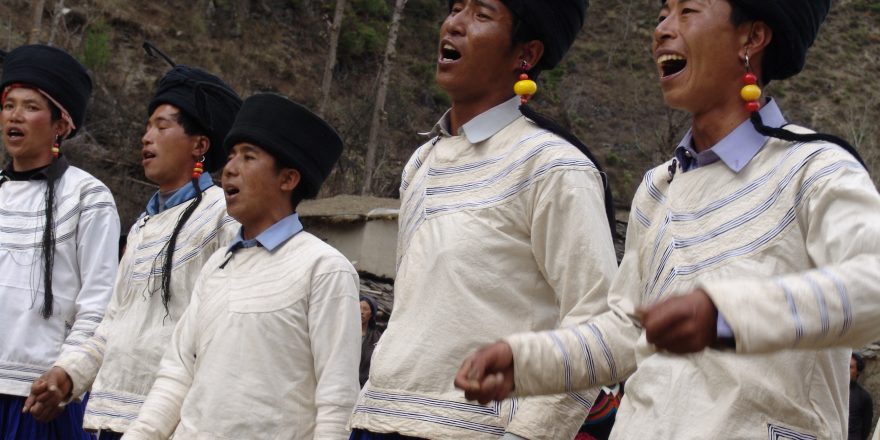
Nuosu, a subgroup of the Yi ethnic minority residing in southwest China, has maintained a long yet continually evolving tradition of verbal dueling from generation to generation. It is called kenre in the local Yi language, which literally means “mouth movement.” The tradition has not only been recorded in historical documents, but continues as a living knowledge contest undertaken primarily for honor and identity and for enlightenment and entertainment throughout the mountainous villages in Liangshan Yi Autonomous Prefecture, Sichuan Province, thereby imbuing audiences both young and old with a sense of cultural identity and strengthening dialogue, cooperation, and respect among Nuosu communities (belonging to three sub-dialect zones) and neighboring Yi areas.
In recent field studies, kenre has been recognized as a key device for carrying out hnewo or epic performance. In general, the verbal contests in which only male can take an active part emerge strictly at a public space in following three contexts: 1) wedding ceremony, 2) funeral cremation, and 3) ritual for sending the dead to ancestral land. As a one-on-one showdown typically crossed verbal swords, the full set of kenre practices is divided into two sessions in a host-guest relationship of two clans and their extended clans allied by marriage; improvisational flyting goes in the first half and epic contests in the second, plus an intermezzo between the two parts.
In the first session, the “battle” begins with friendly yet defiant greetings and moves on to oral competitions that are traditionally undertaken without exception in poetic form, following three bouts: 1) debates on anything the encounters see and hear on the spot, for instance, a flying bird in the sky, a wine cup holding by a headman, the year’s harvest, a newborn child, and so forth; 2) contests of origin narratives refer to the creation of the world, for instance, “the making of heaven and earth,” “the origin of thunder,” “the origin of fire,” and so on; 3) quizzes on creation and knowledge representing the civilization of Nuosu society, for example, the first ancestral inventors and their inventions, tales about the first creator of writings, the first artisan, the first blacksmith, the first craftsman of lacquer work.
After an intermezzo of the verse duel, the competitors return for the second session to “fight it out” through a public contest exchange on hnewo. The male encounters must be at their best to follow up traditional narrative lines that map out a “life-tree” of storytelling, starting from the origins of the epic tradition by tracing back to the “tree root” of hnewo. The exchange then moves on to the nineteen “tree branches” of epic narratives, which are strictly demanded to be performed in public settings: twelve white episodes for a wedding ceremony, seven black episodes for cremation rites, and nineteen white and black episodes for the ritual of sending a dead soul to the ancestral land. The final hnewo exchange, “tree leaves,” narrates the genealogies of more than hundreds of generations.
The celebrated oral warriors called kenre obbusu are teenagers to middle-aged men. (It is not proper for men older than 60 to “show off” in public.). Kenre obbusu are always called upon to wrestle with language, knowledge, wit, eloquence, and humor as each contestant uses the weapon of oral poetry to communicate with the audience who are the final judges.
With a large stock of verbal skills (e.g. boasts, taunts, retorts) and more than twenty rhetorical strategies (e.g. parallel, symmetric, stanzaic) recorded, kenre dueling exhibits a variety of oral genres, revealing Nuosu artistic performances of creation myths, origination narratives, ancestral stories, historical legends, and ritual songs as well as proverbs, riddles, and other local genres. The performances reveal the soul of kenre as a knowledge contest and involve acceptance on the part of the audience, across age and gender. Particularly, in such a cliffhanging storm of “battle,” the epic performance embedded in verbal dueling unfolds an interaction and intersection of verbal art in rites of passage, providing a witness of intangible cultural heritage, dynamic and fluid, not static or fixed.
Kenre Verbal Dueling among the Yi People (彝族克智, file no. I-75) was included in the National Representative List of Intangible Cultural Heritage in 2008. Since then, the Liangshan Society of Yi Studies and the Center for Safeguarding ICH in Liangshan Prefecture—together with traditional bearers and practitioners and supported by local and national authorities and reinforced by research institutions—has proposed and implemented a set of safeguarding measures, encompassing awareness-raising actions, recognition of and subsidies to verbal duelers, documentation and publication of dueling repertoire, training and research program, and exchange in competition. In particular, a field study base devoted to kenre dueling has been built up in Moggu County, where the element is concentratedly practiced both in mountainous villages and in urbanized towns, featuring a collaboration between the local government and the Institute of Ethnic Literature, Chinese Academy of Social Sciences. There remains a long journey ahead, however, to ensure the viability and intergenerational transmission of kenre dueling since the radical social changes have taken place in mountainous communities.
Bamo Qubumo
Senior Research Fellow & Director, Oral Traditions Research Center
Institute of Ethnic Literature, Chinese Academy of Social Sciences
Source: ICH Courier Vol. 34
Add.: FL-11, West Wing, 5 Jiannei Dajie, Beijing 100732, P. R. CHINA
Tel.: +86-10-85196041 Fax.: +86-10-65134585